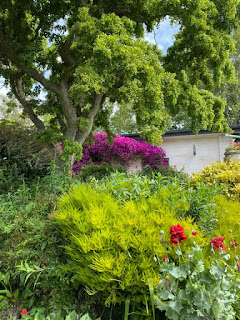 |
| Conifers add to the bones of a garden |
Still cutting back here in our garden, plants that looked stunning through summer but are now just tied and straggly like bush lavatera, mignonette, lavender tops, geraniums, they will all leaf up again to go through winter. The hedge trimmer is on the go as well and seed collecting has ramped up here as I cannot walk past a ripe seed heads without calculating how many new plants I could raise. I plant a few now but save most to sow in spring. However this is a perfect planting time for trees, shrubs, spring bulbs, perennials and annuals. As I have mentioned before it is so worth while buying punnets of annual and perennial seedling now and potting them on into individual pots to grow on and harden off over winter. Some will bud up and flower others will grow strong roots through winter and flower when the ground warms up in spring. Try this with pollyantha, Iceland poppy, lupin, primula, wall flower, stock, snapdragon and if sweet peas are planted in late Autumn they will pop up and sit through winter to flower in August. Bedding plants bought in spring will be soft after being protected by growing in under cover conditions.
This month is said to be the best time to plant conifers, there are not a lot planted or on offer these days, but those that are grown for retail are very ornamental and controllable. I consider conifers contribute to the bones of a garden. Narrow conifers planted in groups give gardens a vertical push and formality. Labels need to be read carefully they give the height and width for the first ten years, after that some do keep growing and should be removed if they start to look untidy, most ornamental conifers look wonderful for years and years. A web site with a comprehensive selection is ttp://www.conifers.co.nz , a good contact for those who like to bonsai.
Bulbs: It's difficult to think about Spring when Autumn about to begin but now is when Spring bulbs are on offer, all that beauty sleeping in bags waiting to be planted. Daffodil species along a roadside fence line, grouped in a vacant paddock, under deciduous trees with bluebells and best thing is they can be forgotten about and happily multiply year after year. If you need to break clumps up do it now because they are beginning to put out roots.
Compost:This is an excellent time to start building a new compost heap and get it heating up before winter. The heating process stops during the coldest months so get one started now with soft trimmings, garden waste and lawn clippings then later on all those leaves that will be falling. Hen manure becomes too hot for heaps during other months but ok to add now.
Lawns. This is said to be the best time to sow a new lawn,because perennial weed growth is slowing.The ground and nights are warm and dew helps with moisture so grass seed will be up in no time. If needed water a new lawn early in the morning instead of during the day, between 6am and 10am, this will ensure that the moisture actually gets down into the soil and to the roots of your grass before the sun evaporates it away. For mature lawns aeration with a fork or a push along spikier is one of the easiest and most effective ways to keep your lawn healthy and happy and best done now, in autumn after your lawn has suffered heavy foot traffic and drought throughout the summer. If a lawn is chocked with thatch then the hiring of a detaching machine would be beneficial.
Vegetables: That last rain was just what veg gardens needed and with the now heavy dew's moisture is perfect for all new plantings. Keep planting in rotation, leaf veg where root veg has been and it is a good time to sow root plants like Asparagus , Beetroot , Carrots , Chives , Leeks ,Onions , Parsnips , Shallots , Spring Onions. When potatoes are dug they need to be kept in the dark or they will go green. I take what I need from a dig and leave the rest in the ground until needed. When the time comes for storing them there are products which will inhibit sprouting, but many gardeners avoid chemicals near food so I will once again mention a natural alternative with you. Layer the stored potatoes with sprigs of rosemary, sage and lavender, the essential oils given off by these herbs not only inhibit sprouting, they will also help to keep the tubers free from bacterial soft rots.
Fruit: Apples, quince, plums, walnuts and late peaches so much at once! the birds must be overjoyed by their feasting and the rats / mice will be munching sunflower seeds and waiting patiently for the walnuts to ripen, I am sure they are pleased with the work we have put in to feed them!
Cheers, Linda
![lawn-new-grass-seed-li758462grass-seed-dscf295[1].jpg](https://blog.petersoncompanies.net/hs-fs/hubfs/lawn-new-grass-seed-li758462grass-seed-dscf295%5B1%5D.jpg?width=320&name=lawn-new-grass-seed-li758462grass-seed-dscf295%5B1%5D.jpg) |
| Best time to sow a new lawn is Autumn |







